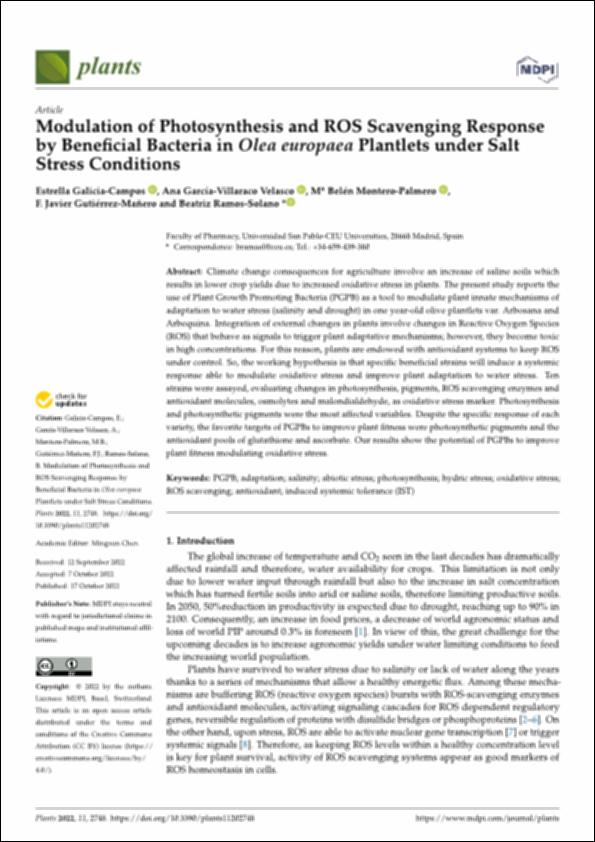Por favor, use este identificador para citar o enlazar este ítem:
http://hdl.handle.net/10637/14708Modulation of Photosynthesis and ROS Scavenging Response by Beneficial Bacteria in Olea europaea Plantlets under Salt Stress Conditions
| Título : | Modulation of Photosynthesis and ROS Scavenging Response by Beneficial Bacteria in Olea europaea Plantlets under Salt Stress Conditions |
| Autor : | Galicia Campos, Estrella García Villaraco, Ana Montero Palmero, María Belén Gutiérrez Mañero, Francisco Javier Ramos Solano, Beatriz |
| Materias: | PGPB; Adaptation; Salinity; Abiotic stress; Photosynthesis; Hydric stress; Oxidative stress; ROS scavenging; Antioxidant; Induced systemic tolerance (IST)) |
| Editorial : | MDPI |
| Citación : | Galicia-Campos, E.; García-Villaraco Velasco, A.; Montero-Palmero,M.B.; Gutiérrez-Mañero, F.J.; Ramos-Solano, B. Modulation of Photosynthesis and ROS Scavenging Response by Beneficial Bacteria in Olea europaea Plantlets under Salt Stress Conditions. Plants 2022, 11, 2748. https://doi.org/ 10.3390/plants11202748 |
| Resumen : | Climate change consequences for agriculture involve an increase of saline soils which results in lower crop yields due to increased oxidative stress in plants. The present study reports the use of Plant Growth Promoting Bacteria (PGPB) as a tool to modulate plant innate mechanisms of adaptation to water stress (salinity and drought) in one year-old olive plantlets var. Arbosana and Arbequina. Integration of external changes in plants involve changes in Reactive Oxygen Species (ROS) that behave as signals to trigger plant adaptative mechanisms; however, they become toxic in high concentrations. For this reason, plants are endowed with antioxidant systems to keep ROS under control. So, the working hypothesis is that specific beneficial strains will induce a systemic response able to modulate oxidative stress and improve plant adaptation to water stress. Ten strains were assayed, evaluating changes in photosynthesis, pigments, ROS scavenging enzymes and antioxidant molecules, osmolytes and malondialdehyde, as oxidative stress marker. Photosynthesis and photosynthetic pigments were the most affected variables. Despite the specific response of each variety, the favorite targets of PGPBs to improve plant fitness were photosynthetic pigments and the antioxidant pools of glutathione and ascorbate. Our results show the potential of PGPBs to improve plant fitness modulating oxidative stress. |
| URI : | http://hdl.handle.net/10637/14708 |
| Derechos: | http://creativecommons.org/licenses/by-nc-nd/4.0/deed.es OpenAccess |
| ISSN : | 2223-7747 |
| Fecha de publicación : | 17-oct-2022 |
| Centro : | Universidad San Pablo-CEU |
| Aparece en las colecciones: | Facultad de Farmacia |
Los ítems de DSpace están protegidos por copyright, con todos los derechos reservados, a menos que se indique lo contrario.


